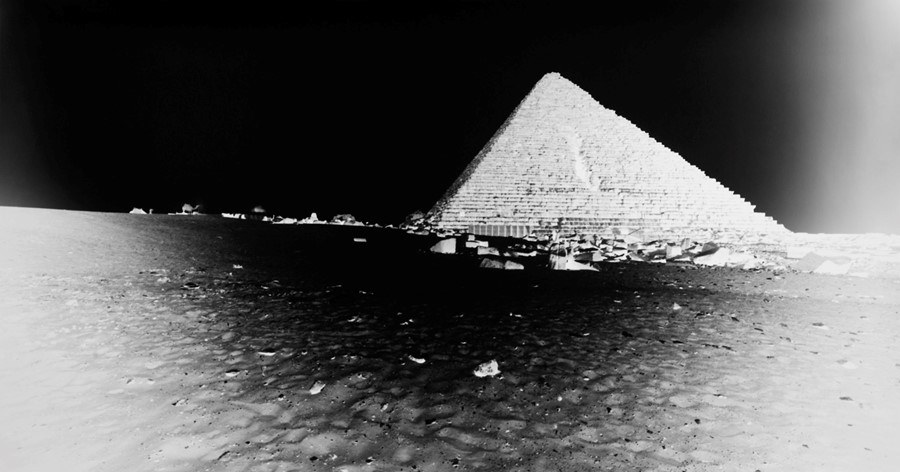Vera Lutter has reinvented Camera Obscura and challenged the way we see the world. Retaining the negative image as her final work, the cities and monuments she captures become unfamiliar and otherworldly.
Vera Lutter has reinvented Camera Obscura and challenged the way we see the world. Retaining the negative image as her final work, the cities and monuments she captures become unfamiliar and otherworldly. With a preoccupation with time, movement and space, Lutter demonstrates photography’s potential and also encourages us to move away from visual conventions and view the world in a new way. In the current exhibition at Gagosian Gallery showing images from her Egypt series, Lutter depicts the isolation and mystery of the ancient monuments that inhabit the desert landscape. Here, she talks to AnOther about the influence that New York has had on her work and the restrictions she faced working in Egypt.
Camera Obscura is the most primitive form of photography. Why and how did you become interested in this?
I was looking for an immediate and direct way to transcribe visual information into a tenuous image. In search for a medium containing myself physically and assuming the same point of perception, it made sense to me to convert the room from which I was seeing into a camera.
Your subjects are nearly always buildings and monuments. What is it about architecture that fascinates you?
I chose my camera to be an architectural device, the camera obscura is literally translated a ‘dark room’, and I consider it conceptually interesting to display the relationship between subject and medium. Important also is that my photographic work was much inspired by my move to New York. The metropolitan environment and my perception of it informed my interest and approach.
Could you tell me about your experience of working in Egypt?
Visiting Egypt was an amazing experience. Working there gave me more time and contact with the people, whom I like very much. I always felt safe and was treated with kindness, respect and often with a liberating sense of humor. Spending time in the desert surrounded by the ancient historic sites was mesmerising and I wish I had time to go back right now. There are many places I have yet to visit. Professional photography was strictly prohibited when I was there last year. Zavier Hawies, the former secretary in charge of all antiquities and historic sites and any art and culture, made photography impossible. In Giza these rules were strictly enforced and I could not move outside of public paths or photograph without permission. Breaking the rules meant fairly serious trouble. Twice I was held and released only through the help and negotiation of an Egyptian friend. Hawies is also the man responsible for keeping many of the pyramids and historic sites inaccessible to visitors. Abu Sir is an antique site closed to the public and the fascinating Black Pyramid in Dahshur is too. The Black Pyramid, as far as I know, has never been open to the public and when I visited, guards were protecting the site with rifles. It was scary to approach the site and I did not go very close but I really doubt anyone would have shot in the end.
Were your preoccupations with time, movement and space the same when you were photographing subject matter for your Egypt series, as they are when you are photographing more contemporary subjects?
These preoccupations were not the same for me when working in Egypt. The Pyramids are fairly still but coincidentally some camels can be seen moving around in some of my photographs.
As well as rendering the world as something unfamiliar and strange, your images also demonstrate photography’s potential, stepping away from visual conventions. Has this always been your intention?
Yes, very much so. In estranging the familiar I have always hoped to invite the recipient to re-examine what is thought or assumed to be common and known and take a new look from a different place. For me photography remains a wonderful medium and as you rightly say a lasting opportunity to circumnavigate visual conventions.
Egypt at Gagosian Gallery, 17-19 Davies Street, London W1K 3DE, runs until 21 May, 2011.
Text by Lola Lalic
